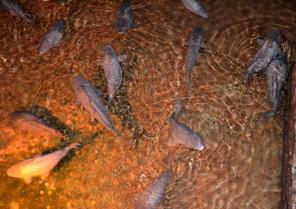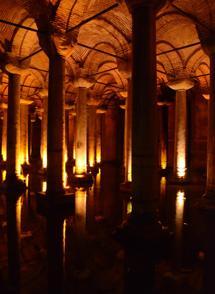Yerebatan Cistern doubling as film set for directors
ISTANBUL – Anadolu Agency

Constructed over 1,400 years ago, Istanbul’s Yerebatan Cistern has in time become one of the city’s most famous tourist sites, drawing millions of visitors every year to its splendid columns and mystical Medusa sculptures. Increasingly, however, the cistern is attracting a new breed of person with camera: film directors.
Some scenes of the latest film in the James Bond series, “Skyfall,” were made in the museum, while it also opened its doors for Russell Crowe’s newest film “The Water Diviner” about the Battle of Gallipoli, said the cistern’s operating officer, Cihat Coşkun.
Scenes of a film based on Dan Brown’s latest novel “Inferno” might also be shot in the cistern, according to Coşkun. “We haven’t got official information about it yet. There are some Turkish firms that they have connections with, but the script is confidential. We don’t know anything about the film and its timeframe.”
Coşkun said that they had also conducted preliminary talks with the producers of a film about the Ertuğrul frigate, an Ottoman which sank 124 years ago off the Japanese coast, resulting in the loss of more than 500 mariners.
“We have made talks about the film, which is on Turkish-Japanese friendship and set to be made in June. Officials asked us to provide information about the Yerebatan Cistern. They said they would shoot some scenes here. We have also talked about the conditions of the filmmaking and explained our conditions here. They said they would come again after the New Year for formal applications. Since it is an international film, they need some presidential permission,” Coşkun said.
 Number of visitors increased during Christmas
Number of visitors increased during Christmas Coşkun said that as well as the Medusa bases, the tear column, wishing well and fish drew the greatest interest from visitors, adding that the museum this year had accepted ticketed and ticket-free visitors.
“In 2014 the cistern was visited by 1,550 million foreign and 370,000 local visitors. Considering the ticket-free visitors, the number of visitors is nearly 2.1 million. We have had 5-10 percent increase when compared to the number of visitors in 2012-2013. We receive more visitors in the summer. Our goal is to reach 2.2 million visitors next year. In the last week of the year, we have had so many visitors because of Christmas as European tourists have been visiting the museum,” he said.
Coşkun said the fish in the cistern were under protection. “We pay attention to the protection of fresh water fish during cleaning. It is said that fish die when they are put in clean water. This is why we take the fish with water when cleaning the cistern. After cleaning, they are put back in the water.”
 Large area
Large areaLocated opposite to the Hagia Sophia in Sultanahmet in the historical peninsula, the cistern was built by Byzantine Emperor Justinian I in 542. The cistern, which is 140 meters long by 70 meters wide, is accessed via 52 stone stairs. There are 336 columns, each of which is nine meters in height in the cistern.
Two upside-down Medusa bases below two columns in the northwestern corner of the cistern are considered to be masterpieces of Roman-era sculpture and are the most popular parts of the cistern for visitors. It is still a mystery as to where the sculptures were brought to the cistern.
It is one the most important spots for tourists visiting Istanbul from all around the world. The cistern was restored by the Istanbul Metropolitan Municipality and opened to visitors in 1987.
 Constructed over 1,400 years ago, Istanbul’s Yerebatan Cistern has in time become one of the city’s most famous tourist sites, drawing millions of visitors every year to its splendid columns and mystical Medusa sculptures. Increasingly, however, the cistern is attracting a new breed of person with camera: film directors.
Constructed over 1,400 years ago, Istanbul’s Yerebatan Cistern has in time become one of the city’s most famous tourist sites, drawing millions of visitors every year to its splendid columns and mystical Medusa sculptures. Increasingly, however, the cistern is attracting a new breed of person with camera: film directors. Number of visitors increased during Christmas
Number of visitors increased during Christmas  Large area
Large area